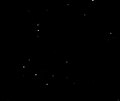File:PIA22413 – Astrophysics CubeSat Demonstrates Big Potential in a Small Package.gif

Original file (840 × 630 pixels, file size: 1.45 MB, MIME type: image/gif, 47 frames, 33 s)
Captions
Captions
Summary
[edit]| DescriptionPIA22413 – Astrophysics CubeSat Demonstrates Big Potential in a Small Package.gif |
English: This animated gif shows a series of images from a single observation of a star by the ASTERIA spacecraft. In the first few images, the star appears to move as ASTERIA slews to and then locks onto the target star. Throughout the remainder of the frames, the spacecraft remains locked on the target star.
ASTERIA, or the Arcsecond Space Telescope Enabling Research in Astrophysics, weighs only 22 pounds (10 kilograms). It carries a payload for measuring the brightness of stars, which allows researchers to monitor nearby stars for orbiting exoplanets that cause a brief drop in brightness as they block the starlight. The ASTERIA mission utilized commercially available CubeSat hardware where possible, and is contributing to a general knowledge of how those components operate in space. The ASTERIA satellite, which was deployed into low-Earth orbit in November, is only slightly larger than a box of cereal, but it could be used to help astrophysicists study planets orbiting other stars. ASTERIA was developed under the Phaeton Program at JPL. Phaeton provides early-career hires, under the guidance of experienced mentors, with the challenges of a flight project. ASTERIA is a collaboration with the Massachusetts Institute of Technology in Cambridge; where Sara Seager is the principal investigator. Mission managers at NASA's Jet Propulsion Laboratory in Pasadena, California, recently announced that ASTERIA has accomplished all of its primary mission objectives, demonstrating that the miniaturized technologies on board can operate in space as expected. This marks the success of one of the world's first astrophysics CubeSat missions, and shows that small, low-cost satellites could be used to assist in future studies of the universe beyond the solar system. |
| Date | 13 April 2018 (published) |
| Source | Catalog page · Full-res (GIF) |
| Author | NASA/JPL-Caltech |
| Other versions |
|
This image or video was catalogued by Jet Propulsion Laboratory of the United States National Aeronautics and Space Administration (NASA) under Photo ID: PIA22413. This tag does not indicate the copyright status of the attached work. A normal copyright tag is still required. See Commons:Licensing. Other languages:
العربية ∙ беларуская (тарашкевіца) ∙ български ∙ català ∙ čeština ∙ dansk ∙ Deutsch ∙ English ∙ español ∙ فارسی ∙ français ∙ galego ∙ magyar ∙ հայերեն ∙ Bahasa Indonesia ∙ italiano ∙ 日本語 ∙ македонски ∙ മലയാളം ∙ Nederlands ∙ polski ∙ português ∙ русский ∙ sicilianu ∙ slovenščina ∙ Türkçe ∙ українська ∙ 简体中文 ∙ 繁體中文 ∙ +/− |
 |
This media is a product of the ASTERIA mission Credit and attribution belongs to the mission team, if not already specified in the "author" row |
Licensing
[edit]| Public domainPublic domainfalsefalse |
| This file is in the public domain in the United States because it was solely created by NASA. NASA copyright policy states that "NASA material is not protected by copyright unless noted". (See Template:PD-USGov, NASA copyright policy page or JPL Image Use Policy.) |  | |
 |
Warnings:
|
File history
Click on a date/time to view the file as it appeared at that time.
| Date/Time | Thumbnail | Dimensions | User | Comment | |
|---|---|---|---|---|---|
| current | 15:24, 16 April 2018 |  | 840 × 630 (1.45 MB) | PhilipTerryGraham (talk | contribs) | User created page with UploadWizard |
You cannot overwrite this file.
File usage on Commons
The following 6 pages use this file:
- Commons:WikiProject Aviation/recent uploads/2018 April 16
- File:PIA22413 – Astrophysics CubeSat Demonstrates Big Potential in a Small Package, Figure 1.jpg
- File:PIA22413 – Astrophysics CubeSat Demonstrates Big Potential in a Small Package, Figure 2.jpg
- File:PIA22413 – Astrophysics CubeSat Demonstrates Big Potential in a Small Package, Figure 3.gif
- File:PIA22413 – Astrophysics CubeSat Demonstrates Big Potential in a Small Package, Figure 4.jpg
- File:PIA22413 – Astrophysics CubeSat Demonstrates Big Potential in a Small Package.gif




